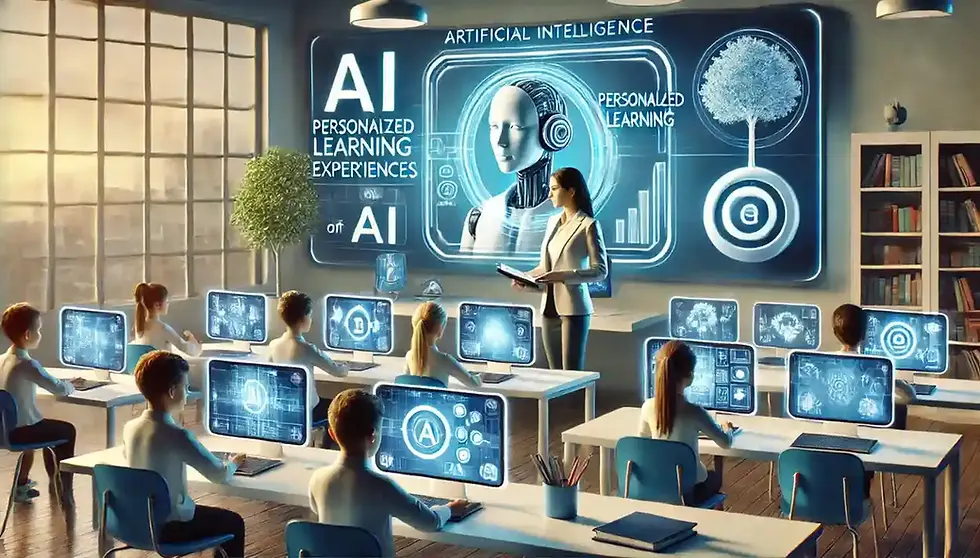The Role of AI in Personalizing Education
- Vinaya Souz
- Aug 3, 2024
- 4 min read
The integration of artificial intelligence (AI) in education is revolutionizing the way we approach teaching and learning. AI technologies enable personalized learning experiences tailored to individual students' needs, preferences, and learning styles. This article explores the role of AI in education, its benefits, and how educators can leverage AI tools to create a more personalized and effective learning environment.

Understanding Personalized Learning
Personalized learning refers to instructional approaches designed to cater to the unique needs of each student. Unlike traditional one-size-fits-all methods, personalized learning adapts to the pace, interests, and learning styles of individual students. AI plays a crucial role in facilitating this customization by analyzing student data and providing insights that inform tailored educational strategies.
Benefits of AI in Personalized Learning
1. Adaptive Learning Paths
One of the most significant advantages of AI in education is the ability to create adaptive learning paths. AI algorithms can analyze student performance and adjust the difficulty level and content of lessons accordingly. This ensures that students are neither bored with material that is too easy nor overwhelmed by content that is too challenging. Adaptive learning paths help maintain student engagement and promote a deeper understanding of the subject matter.
2. Real-Time Feedback and Assessment
AI-powered tools can provide real-time feedback and assessment, allowing students to understand their progress and identify areas for improvement immediately. This instant feedback helps students correct mistakes and reinforce learning in a timely manner. Educators can also use this data to adjust their teaching strategies and provide targeted support where needed.
3. Data-Driven Insights
AI can analyze vast amounts of data to identify patterns and trends in student performance. These data-driven insights enable educators to understand each student's strengths, weaknesses, and learning preferences. By leveraging this information, teachers can design personalized learning experiences that cater to the specific needs of their students.
4. Increased Efficiency for Educators
AI tools can automate administrative tasks such as grading, attendance tracking, and lesson planning, freeing up time for educators to focus on more strategic aspects of teaching. This increased efficiency allows teachers to dedicate more time to developing personalized learning plans and providing individualized support to students.
Leveraging AI Learning Tools
1. AI-Powered Learning Platforms
Several AI-powered learning platforms offer personalized learning experiences. Tools like TeachiQuo, DreamBox, and Smart Sparrow use AI algorithms to adapt content and provide tailored educational experiences. These platforms can assess student performance, recommend resources, and create customized learning paths.
2. Intelligent Tutoring Systems
Intelligent tutoring systems (ITS) use AI to provide one-on-one tutoring to students. These systems can simulate the role of a human tutor by offering personalized instruction, feedback, and support. Examples of ITS include Carnegie Learning and Knewton, which adapt to students' learning needs and provide targeted interventions.
3. Chatbots and Virtual Assistants
AI chatbots and virtual assistants can support personalized learning by answering student queries, providing guidance, and offering additional resources. These tools are available 24/7, ensuring that students have access to help whenever they need it. Examples include IBM Watson Tutor and Microsoft Azure AI.
4. AI-Driven Content Creation
AI can assist educators in creating personalized content by generating quizzes, practice exercises, and learning materials tailored to individual student needs. Tools like Content Technologies, Inc. (CTI) and Querium use AI to develop customized educational resources that align with specific learning objectives.
Best Practices for Implementing AI in Personalized Learning
1. Start with Clear Objectives
Before implementing AI tools, define clear learning objectives and goals. Determine what you aim to achieve with personalized learning and how AI can support these objectives. Having a clear vision will guide your AI integration efforts and ensure they are aligned with your educational goals.
2. Choose the Right AI Tools
Select AI tools that best meet the needs of your students and align with your teaching objectives. Consider factors such as ease of use, features, and compatibility with your existing systems. Research different AI platforms and tools to find the ones that offer the best value and functionality.
3. Train Educators and Students
Provide training for both educators and students on how to use AI tools effectively. Ensure that teachers understand how to leverage AI to enhance personalized learning and that students are comfortable using the technology. Ongoing professional development and support are essential for successful AI integration.
4. Monitor and Evaluate
Regularly monitor the impact of AI on student learning outcomes and adjust your strategies as needed. Collect data on student performance, engagement, and satisfaction to evaluate the effectiveness of AI tools. Use this feedback to refine your approach and continuously improve the personalized learning experience.
Conclusion
The role of AI in education is transforming personalized learning by providing adaptive learning paths, real-time feedback, and data-driven insights. By leveraging AI learning tools, educators can create tailored educational experiences that cater to the unique needs of each student. This personalized approach enhances student engagement, improves learning outcomes, and prepares students for success in a tech-driven world.
As technology continues to advance, the potential for AI in education will only grow, offering new opportunities to enhance personalized learning. By embracing these innovations, educators can stay at the forefront of educational technology and provide their students with the best possible learning experiences. Explore the possibilities of AI in education and transform your teaching practices with personalized, dynamic learning solutions.




Comments